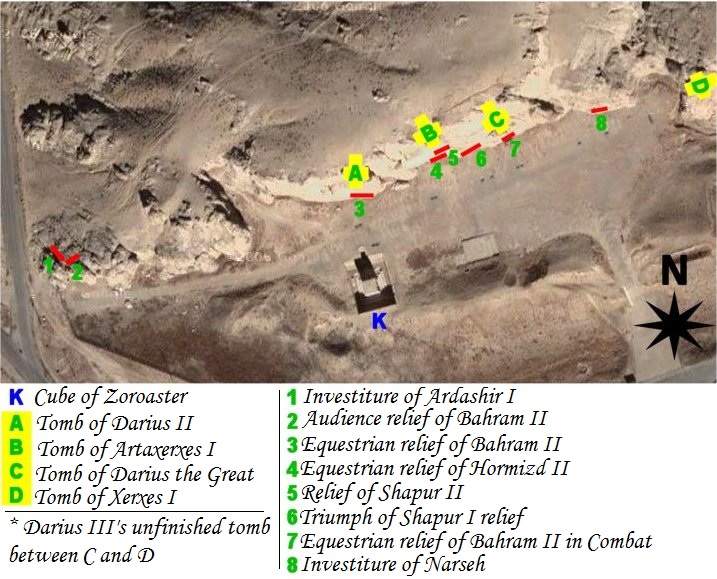|
Ohrmazd
Ahura Mazda (; ; or , ),The former is the New Persian rendering of the Avestan form, while the latter derives from Middle Persian. also known as Horomazes (),, is the only creator deity and god of the sky in the ancient Iranian religion Zoroastrianism. He is the first and most frequently invoked spirit in the ''Yasna''. The literal meaning of the word ''Ahura'' is "lord", and that of ''Mazda'' is "wisdom". The first notable invocation of Ahura Mazda occurred during the Achaemenid period () with the Behistun Inscription of Darius the Great. Until the reign of Artaxerxes II (), Ahura Mazda was worshipped and invoked alone in all extant royal inscriptions. With Artaxerxes II, Ahura Mazda was gathered in a triad with Mithra and Anahita. In the Achaemenid period, there are no known representations of Ahura Mazda at the royal court other than the custom for every emperor to have an empty chariot drawn by white horses to invite Ahura Mazda to accompany the Persian army on battl ... [...More Info...] [...Related Items...] OR: [Wikipedia] [Google] [Baidu] |
Zurvan (God)
Zurvanism is a fatalistic religious movement of Zoroastrianism in which the divinity Zurvan is a first principle (primordial creator deity) who engendered equal-but-opposite twins, Ahura Mazda and Angra Mainyu. Zurvanism is also known as "Zurvanite Zoroastrianism", and may be contrasted with Mazdaism. In Zurvanism, Zurvan was perceived as the god of infinite time and space and also known as "one" or "alone." Zurvan was portrayed as a transcendental and neutral god without passion; one for whom there was no distinction between good and evil. The name ''Zurvan'' is a normalized rendition of the word, which in Middle Persian appears as either ''Zurvān'', ''Zruvān'' or ''Zarvān''. The Middle Persian name derives from Avestan (, a grammatically neuter noun). Origins and background Although the details of the origin and development of Zurvanism remain murky (for a summary of the three opposing opinions see below), it is generally accepted that Zurvanism was: : (1) a branch of ... [...More Info...] [...Related Items...] OR: [Wikipedia] [Google] [Baidu] |
Zoroastrianism
Zoroastrianism ( ), also called Mazdayasnā () or Beh-dīn (), is an Iranian religions, Iranian religion centred on the Avesta and the teachings of Zoroaster, Zarathushtra Spitama, who is more commonly referred to by the Greek translation, Zoroaster ( ). Among the world's oldest organized faiths, its adherents exalt an Creator deity, uncreated, Omnibenevolence, benevolent, and List of knowledge deities#Persian mythology, all-wise deity known as Ahura Mazda (), who is hailed as the supreme being of the universe. Opposed to Ahura Mazda is Ahriman, Angra Mainyu (), who is personified as a List of death deities#Persian-Zoroastrian, destructive spirit and the adversary of all things that are good. As such, the Zoroastrian religion combines a Dualism in cosmology, dualistic cosmology of good and evil with an eschatological outlook predicting the Frashokereti, ultimate triumph of Ahura Mazda over evil. Opinions vary among scholars as to whether Zoroastrianism is monotheistic, polyth ... [...More Info...] [...Related Items...] OR: [Wikipedia] [Google] [Baidu] |
Ahriman
Angra Mainyu (; ) is the Avestan name of Zoroastrianism's hypostasis of the "destructive/evil spirit" and the main adversary in Zoroastrianism either of the Spenta Mainyu, the "holy/creative spirits/mentality", or directly of Ahura Mazda, the highest deity of Zoroastrianism. The Middle Persian equivalent is Ahriman (anglicised pronunciation: ). The name can appear in English-language works as Ahrimanes. In the Avesta In Zoroaster's revelation Avestan ''angra mainyu'' "seems to have been an original conception of Zoroaster's." In the Gathas, which are the oldest texts of Zoroastrianism and are attributed to Zoroaster, ''angra mainyu'' is not yet a proper name.Proper names are altogether rare in the Gathas. In these texts, even Ahura Mazda and Amesha Spenta are not yet proper names. In the one instance in these hymns where the two words appear together, the concept spoken of is that of a ''mainyu'' ("mind", "spirit" or otherwise an abstract energy etc.)The translation of '' ... [...More Info...] [...Related Items...] OR: [Wikipedia] [Google] [Baidu] |
Naqsh-e Rostam
Naqsh-e Rostam (; , ) is an ancient archeological site and necropolis located about 13 km northwest of Persepolis, in Fars province, Iran. A collection of ancient Iranian rock reliefs are cut into the face of the mountain and the mountain contains the final resting place of four Achaemenid kings, notably king Darius the Great and his son, Xerxes. This site is of great significance to the history of Iran and to Iranians, as it contains various archeological sites carved into the rock wall through time for more than a millennium from the Elamites and Achaemenids to Sassanians. It lies a few hundred meters from Naqsh-e Rajab, with a further four Sassanid rock reliefs, three celebrating kings and one a high priest. Naqsh-e Rostam is the necropolis of the Achaemenid dynasty ( 550–330 BC), with four large tombs cut high into the cliff face. These have mainly architectural decoration, but the facades include large panels over the doorways, each very similar in conten ... [...More Info...] [...Related Items...] OR: [Wikipedia] [Google] [Baidu] |
Sky Deity
The sky often has important religious significance. Many polytheistic religions have deities associated with the sky. The daytime sky deities are typically distinct from the nighttime ones. Stith Thompson's ''Motif-Index of Folk-Literature'' reflects this by separating the category of "Sky-god" (A210) from that of "Star-god" (A250). In mythology, nighttime gods are usually known as night deities and gods of stars simply as star gods. Both of these categories are included here since they relate to the sky. Luminary deities are included as well since the sun and moon are located in the sky. Some religions may also have a deity or personification of the day, distinct from the god of the day lit sky, to complement the deity or personification of the night. Daytime gods and nighttime gods are frequently deities of an " upper world" or "celestial world" opposed to the earth and a " netherworld" (gods of the underworld are sometimes called "chthonic" deities). Within Greek mythology ... [...More Info...] [...Related Items...] OR: [Wikipedia] [Google] [Baidu] |
Ardashir I
Ardashir I (), also known as Ardashir the Unifier (180–242 AD), was the founder of the Sasanian Empire, the last empire of ancient Iran. He was also Ardashir V of the Kings of Persis, until he founded the new empire. After defeating the last Parthian Empire, Parthian King of Kings, shahanshah Artabanus IV of Parthia, Artabanus IV on the Battle of Hormozdgan, Hormozdgan plain in 224, he overthrew the Parthian Empire, Arsacid dynasty and established the Sasanian dynasty. Afterwards, Ardashir called himself ''shahanshah'' and began conquering the land that he called ''Iran (word), Eranshahr'', the realm of the Arya (Iran), Iranians. There are various historical reports about Ardashir's lineage and ancestry. According to al-Tabari's ''History of the Prophets and Kings'', Ardashir was son of Papak, son of Sasan. Another narrative recorded in Kar-Namag i Ardashir i Pabagan, ''Kar-Namag i Ardashir i Pabagan'' and Ferdowsi, Ferdowsi's ''Shahnameh'' states that Ardashir was born from the ... [...More Info...] [...Related Items...] OR: [Wikipedia] [Google] [Baidu] |
Yasna
Yasna (; ''''. ) is the name of 's principal act of worship. It is also the name of the primary liturgical collection of texts, recited during that ''yasna'' ceremony. Overview The function of the ''yasna'' ceremon ...[...More Info...] [...Related Items...] OR: [Wikipedia] [Google] [Baidu] |
DK (publisher)
Dorling Kindersley Limited (branded as DK) is a British multinational publishing company specialising in illustrated reference books for adults and children in 63 languages. It is part of Penguin Random House, a subsidiary of German media conglomerate Bertelsmann. Established in 1974, DK publishes a range of titles in genres including travel (including DK Eyewitness Travel), history, geography, science, space, nature, sports, gardening, cookery, parenting and many others. The worldwide CEO of DK is Paul Kelly. DK has offices in New York, Melbourne, London, Munich, New Delhi, Toronto, Madrid, Beijing, and Jiangmen. DK works with licensing partners such as Disney, LEGO, DC Comics, the Royal Horticultural Society, MasterChef, and the Smithsonian Institution. DK has commissioned authors such as Mary Berry, Monty Don, Robert Winston, Huw Richards, and Steve Mould for a range of books. History DK was founded in 1974 by Christopher Dorling and Peter Kindersley in London as a ... [...More Info...] [...Related Items...] OR: [Wikipedia] [Google] [Baidu] |
Mazda
is a Japanese Multinational corporation, multinational automotive manufacturer headquartered in Fuchū, Hiroshima (town), Fuchū, Hiroshima Prefecture, Hiroshima, Japan. The company was founded on January 30, 1920, as Toyo Cork Kogyo Co., Ltd., a cork-making factory, by Jujiro Matsuda. The company then acquired Abemaki Tree Cork Company. It changed its name to Toyo Kogyo Co., Ltd. in 1927 and started producing vehicles in 1931. Mazda is known for its innovative technologies, such as the Wankel engine, the SkyActiv platform, and the Kodo Design language. It also has a long history of motorsport involvement, winning the 24 Hours of Le Mans in 1991 with the rotary-powered Mazda 787B. In the past and present, Mazda has been engaged in alliances with other automakers. From 1974 until the late 2000s, Ford Motor Company, Ford was a major shareholder of Mazda. Other partnerships include Toyota, Nissan, Isuzu, Suzuki and Kia. In 2023, it produced 1.1 million vehicles globally. The ... [...More Info...] [...Related Items...] OR: [Wikipedia] [Google] [Baidu] |
Ahura
Ahura (Avestan: 𐬀𐬵𐬎𐬭𐬀) is an Avestan language designation of a type of deity inherited by Zoroastrianism from the prehistoric Indo-Iranian religion, and denotes a particular class of Zoroastrian divinities. The term is assumed to be linguistically related to the Asuras of Indian Vedic era. Etymology Avestan ''ahura'' "lord" derives from Proto-Indo-Iranian language ''*Hásuras'', also attested in an Indian context as Rigvedic ''asura''. As suggested by the similarity to the Old Norse ''æsir'', Indo-Iranian ''*Hásuras'' may have an even earlier Proto-Indo-European language root. The ''Rigveda'' says that Asura such as the “Father Asura”, Varuṇa, and Mitra, are “older gods” who originally ruled over the primeval undifferentiated Chaos. It is commonly supposed that Indo-Iranian ''*Hásuras'' was the proper name of a specific divinity with whom other divinities were later identified. In scripture Gathas In the Gathas, the oldest hymns of Zoroastrianism ... [...More Info...] [...Related Items...] OR: [Wikipedia] [Google] [Baidu] |




